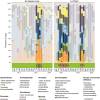Resilience of Freshwater Communities of Small Microbial Eukaryotes Undergoing Severe Drought Events
- PMID: 27303393
- PMCID: PMC4885337
- DOI: 10.3389/fmicb.2016.00812
Resilience of Freshwater Communities of Small Microbial Eukaryotes Undergoing Severe Drought Events
Abstract
Small and shallow aquatic ecosystems such as ponds and streams constitute a significant proportion of continental surface waters, especially in temperate zones. In comparison with bigger lakes and rivers, they harbor higher biodiversity but they also exhibit reduced buffering capacity face to environmental shifts, such that climate global change can affect them in a more drastic way. For instance, many temperate areas are predicted to undergo droughts with increasing frequency in the near future, which may lead to the temporal desiccation of streams and ponds. In this work, we monitored temporal dynamics of planktonic communities of microbial eukaryotes (cell size range: 0.2-5 μm) in one brook and one pond that experienced recurrent droughts from 1 to 5 consecutive months during a temporal survey carried out monthly for 2 years based on high-throughput 18S rDNA metabarcoding. During drought-induced desiccation events, protist communities present in the remaining dry sediment, though highly diverse, differed radically from their planktonic counterparts. However, after water refill, the aquatic protist assemblages recovered their original structure within a month. This rapid recovery indicates that these eukaryotic communities are resilient to droughts, most likely via the entrance in dormancy. This property is essential for the long-term survival and functional stability of small freshwater ecosystems.
Keywords: 18S rRNA; dormancy; plankton; protist; resilience; temporal dynamics.
Figures





References
-
- Bachy C., Dolan J. R., López-García P., Deschamps P., Moreira D. (2013). Accuracy of protist diversity assessments: morphology compared with cloning and direct pyrosequencing of 18S rRNA genes and ITS regions using the conspicuous tintinnid ciliates as a case study. ISME J. 7 244–255. 10.1038/ismej.2012.106 - DOI - PMC - PubMed
-
- Bamforth S. S. (1958). Ecological studies on the planktonic protozoa of a small artificial pond. Limnol. Oceanogr. 3 398–412. 10.4319/lo.1958.3.4.0398 - DOI
-
- Bray J. R., Curtis J. T. (1957). An ordination of the upland forest communities of southern wisconsin. Ecol. Monogr. 27 325–349. 10.2307/1942268 - DOI
Grants and funding
LinkOut - more resources
Full Text Sources
Other Literature Sources

